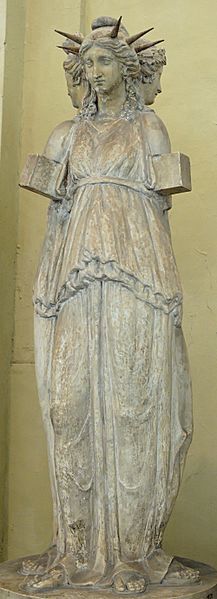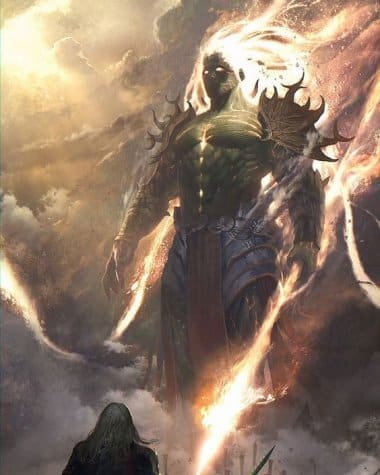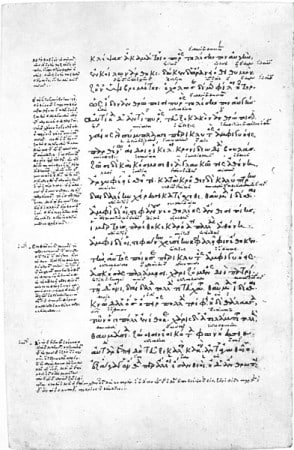In the vast and intricate tapestry of Greek mythology, the figure of Perses, a Titan, emerges with a narrative that is both compelling and instructive. His tale, though not as frequently recounted as those of Zeus or Hercules, holds a unique place in the annals of ancient lore. Perses, whose name echoes with the resonance of destruction, invites us into a realm where the primal forces of the cosmos dance in a delicate balance.
The Titans, often overshadowed by the more popular Olympian gods, were nevertheless pivotal in the shaping of the ancient Greek cosmic order. Among them, Perses, son of the Titans Crius and Eurybia, embodies a fascinating blend of destructive force and the potential for transformation. His narrative, though lesser-known, is a riveting part of the ancient Greek mythological narrative, offering a glimpse into the primal forces that once were believed to govern the cosmos.
Perses Key Facts
| Parents | Crius and Eurybia |
| Partners | Asteria |
| Siblings | Astraeus, Pallas |
| Offspring | Hecate |
| Other names | – |
| Roman name | Perses |
| The God of | Destruction |
Name and Etymology
The name Perses, derived from the ancient Greek word pertho, meaning “to destroy”, is a fitting moniker for a deity associated with destruction. This etymological root paints a vivid picture of the fearsome power that Perses was believed to wield. The name itself serves as a stark reminder of the inexorable forces of change and destruction inherent in the natural order.
In the Roman tradition, Perses retains his Greek name, a testament to the enduring resonance of his destructive aspect across cultures. Unlike many other Greek deities, Perses didn’t undergo a name change in the transition to Roman mythology. This consistency in nomenclature across cultures underscores the universal recognition of the primal force of destruction he represents.
Besides his primary name, there are no significant epithets or alternative names associated with Perses. This lack of additional monikers is somewhat unusual in the realm of ancient mythology. There, gods often have numerous names reflecting their various aspects and deeds. The singular name of Perses, however, stands unadorned. Its stark simplicity mirroring the uncompromising, unyielding nature of the force he embodies.
Perses Origins
Born to the Titans Crius and Eurybia, Perses, along with his siblings Astraeus and Pallas, was part of a divine lineage that predated the Olympian gods. His immediate family was a powerful lineage of Titans, beings that embodied the fundamental forces of the cosmos. The births of Perses, Astraeus, and Pallas were cosmic events that further enriched the complex tableau of ancient Greek mythology.
There isn’t much detailed insight regarding the birth or childhood of Perses. His narrative primarily begins with his adulthood, where his destructive aspect comes to the fore. However, his lineage itself speaks volumes about his inherent power and the role he was destined to play in the unfolding cosmic drama.
Perses, in Greek myth, is often seen as a personification of destruction, a Daemones (Spirit) representing a primal force. His role, though not elaborately chronicled like those of Zeus or Poseidon, is crucial in understanding the ancient Greek perception of the destructive yet transformative forces of nature.
Perses Lovers and Relationships
The narrative of Perses takes a tender turn when it comes to his relationship with Asteria, the starry-night goddess. Their union was not just a romantic alliance but a cosmic intertwining of destructive and celestial forces.
Relationship with Asteria
Perses and Asteria’s union was symbolic of a profound cosmic balance. Asteria, whose domain was the night sky, brought a celestial calm to the destructive nature of Perses. Their relationship was a beautiful depiction of how contrasting forces could come together to create harmony in the ancient Greek cosmos.
Their union bore fruit in the form of Hecate, a goddess of magic, witchcraft, and the night. Hecate inherited traits from both her parents, embodying the mystery of the night sky and the transformative power of destruction. Through her, the narrative of Perses and Asteria continued to echo in the annals of Greek mythology. Indeed a testament to the enduring legacy of their union.
Perses Daughter Hecate
Hecate, the daughter of Perses and Asteria, is a deity of significant importance in Greek mythology. Her lineage endowed her with a unique blend of powers, making her a revered figure in the ancient Greek pantheon.

Hecate’s divine heritage allowed her to traverse between the realms of mortals and gods. Moreover, she was a mediator of sorts between the seen and unseen worlds. Her story is a fascinating exploration of how the primal forces embodied by her parents continued to play out in the unfolding drama of Greek mythology.
Depiction And Characteristics
Perses, like many ancient deities, is a figure shrouded in mystery and awe. His depiction in ancient texts and artistry provides a glimpse into how the ancient Greeks perceived the primal force of destruction he represented.
Often, he is depicted as a robust figure, embodying the raw, unyielding force of destruction. The imagery associated with Perses is sparse, yet evocative, encapsulating the awe and fear his destructive aspect invoked.

Symbols directly associated with Perses are scarce, which is somewhat unusual for a deity of his stature. However, this lack of symbolic representation could be seen as a reflection of the straightforward, unadorned nature of the destructive force he embodies.
Perses Personality
The personality of Perses, as gleaned from ancient texts, is as straightforward as his name suggests. He embodies destruction, a force that is both feared and revered for its ability to clear the old to make way for the new. His actions within the myths are often direct. This reflect a deity unencumbered by the whims and intrigues that characterize many other figures in Greek mythology.
His perception by the ancient Greeks was likely a mix of awe and fear. The destructive force he represented was necessary for the cycle of creation, preservation, and destruction that governed the cosmos, yet it was a force that came with a cost, a price paid in the currency of change and transformation.
Perses Powers
The powers of Perses are rooted in his domain of destruction. He embodies a force capable of dismantling the old, clearing the way for the new. This destructive aspect, while fearsome, is also a catalyst for change and transformation, a necessary component in the ever-evolving cosmos.
The ancient Greeks, with their understanding of the cyclical nature of existence, recognized the essential role that Perses played in the cosmic order. His powers, though destructive, were seen as a natural part of the divine scheme. A necessary force that kept the wheels of creation turning.
Perses Roles And Responsibilities
The role of Perses in the ancient Greek mythological narrative is both simple and profound. As a deity of destruction, his primary responsibility was to embody the force that dismantles the old. In so doing, he was making way for the new. This role, though not elaborately detailed in myths, is a fundamental aspect of the cosmic order.
The responsibilities of Perses, as a deity of destruction, were likely seen as both a blessing and a curse. While destruction cleared the way for new growth, it also came with a cost, a price paid in the currency of loss and change. This dual nature of Perses’s role reflects the ancient Greek understanding of the delicate balance that governs the cosmos.
The narrative of Perses invites us to explore the primal forces that shape our existence. His tale, though not as frequently recounted as those of Zeus or Hercules, holds a unique place in the annals of ancient lore, offering a glimpse into the ancient understanding of the cyclical nature of existence.
Myths about Perses
The myths surrounding Perses are not as numerous or elaborate as those of some other deities. However, his narrative is intertwined with the broader tapestry of Greek mythology, offering a glimpse into the primal forces at play in the ancient Greek cosmic order.
The Birth of Hecate
One of the most significant myths associated with Perses is the birth of his daughter Hecate. His union with Asteria, a goddess of the night sky, resulted in the birth of a deity who would become a significant figure in Greek mythology. Thei daughter is Hecate, who has a unique blend of celestial and destructive powers. She embody the harmonious union of contrasting forces, a theme that resonates throughout Greek mythology.
Hecate’s birth and her subsequent deeds is a testament to the enduring legacy of Perses and Asteria’s union. Through Hecate, the narrative of Perses continues to echo in the annals of Greek mythology. A Lasting reminder of the delicate balance between destruction and creation.
The tale of Hecate’s birth is a fascinating exploration of how the primal forces embodied by Perses and Asteria played out in the unfolding drama of Greek mythology. Through her, the legacy of Perses lives on, a testament to the enduring resonance of his narrative.
Representations Of Perses In Art
The representation of Perses in ancient art is not as extensive as that of more popular deities like Zeus or Athena. However, the few depictions that exist offer a glimpse into how the ancient Greeks visualized the force of destruction he embodied.
The imagery associated with Perses often portrays him as a robust, formidable figure, a visual representation of the fearsome power he wielded. These depictions, are evocative, encapsulating the awe and fear his destructive aspect invoked.
The artistry of ancient Greece, with its focus on depicting the divine, offers a window into the perception of Perses. Though not as frequently depicted as other deities, the imagery associated with Perses is a compelling exploration of the ancient understanding of the primal force of destruction.
Mentions in Ancient Texts
Mentions of Perses in ancient texts are not as extensive as those of more popular deities. However, they offer a glimpse into the ancient Greek perception of the force of destruction he embodied. Several authors have touched upon his story, each contributing to the understanding of this Titan’s role in the cosmic order.
Hesiod’s “Theogony” (circa 700 BC)

Hesiod is a revered ancient Greek poet often considered a contemporary of Homer. He delves into the lineage and deeds of the Titans in his seminal work the “Theogony.” Written around 700 BC, this text is a foundational piece of Greek mythology. It chronicles the origins of the gods and the cosmos from chaos to the reign of the Olympians. In “Theogony,” Hesiod mentions Perses as a son of Crius and Eurybia, and the father of Hecate. He states:
“…And Eurybia, bright goddess, was joined in love to Crius and bore great Astraeus, and Pallas, and Perses who was preeminent among all men in wisdom.”
Apollodorus’s “Bibliotheca” (1st or 2nd century AD)
Apollodorus, believed to have lived in the 1st or 2nd century AD, is credited with the compilation of “Bibliotheca,” a comprehensive encyclopedia of Greek mythology. Though not much is known about Apollodorus himself, his work remains a significant source of Greek mythological knowledge. In “Bibliotheca,” Apollodorus briefly mentions Perses in the context of his lineage, reaffirming his place in the family of Titans.
Hyginus’s “Fabulae” (1st century BC)
Gaius Julius Hyginus, a Latin author and scholar of the 1st century BC, penned “Fabulae,” a collection of Roman myths and legends. Though a Roman author, Hyginus often drew from Greek sources, and his work serves as a bridge between Greek and Roman mythological traditions. In “Fabulae,” Hyginus too touches upon the lineage of Perses, echoing the narrative presented by Hesiod and Apollodorus.
Frequently Asked Questions
Perses was born to the Titans Crius and Eurybia, a lineage that endowed him with the primal force of destruction.
The union between Perses and Asteria was a cosmic intertwining of destructive and celestial forces. It resulted in the birth of Hecate, a significant deity in Greek mythology.
Perses embodies the primal force of destruction, a necessary aspect of the cosmic order. It clears the way for new growth and transformation.
One of the most significant myths associated with Perses is the birth of his daughter Hecate. She is a deity of magic, witchcraft, and the night.
Perses was likely perceived with a mix of awe and fear. Moreover, as the destructive force he represented was both necessary and fearsome.
Featured Image Credit: Père Igor, CC BY-SA 4.0, via Wikimedia Commons
